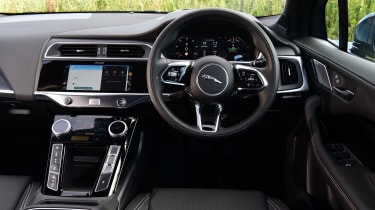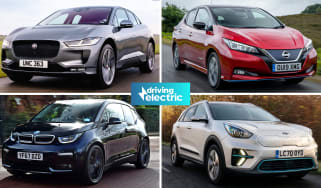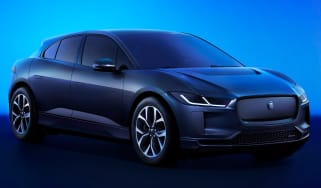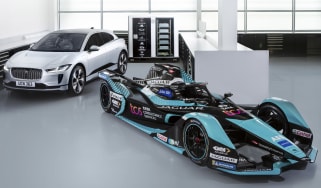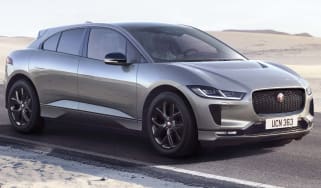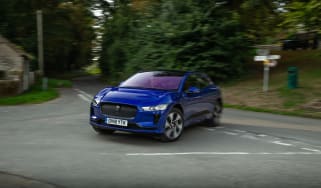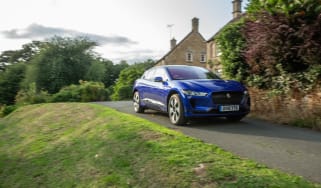Jaguar I-Pace review
The Jaguar I-Pace remains a solid choice if you’re after an electric SUV that’s as luxurious as it is fun to drive – though rivals now offer more range and faster charging
Pros
- Good standard equipment
- Great handling
- Striking looks and performance
Cons
- Suspension is firm
- Others charge more quickly
- Disappointing real-world range
| Car type | Range | Wallbox charge time | Rapid charge time |
|---|---|---|---|
| Electric | 286 miles | 13hrs 30mins (0-100%, 7.4kW) | 47mins (10-80%, 100kW) |
Jaguar I-Pace verdict
The Jaguar I-Pace was an impressive first attempt at an electric car for the brand, but five years after its initial launch, there are some areas in which the plug-in Jag is beginning to feel a little long in the tooth. In 2023 it’s a bit of a shame that a £70k electric SUV can’t manage over 300 miles on a charge, and with charging speeds of just 100kW, it’s outgunned by much cheaper models like the Kia EV6. To its merit, the Jaguar I-Pace still offers sharp handling and a well-trimmed interior, but if you’re after a posh electric car that’s fun to drive, the compelling BMW iX only costs slightly more.
Range details, specs and alternatives
The Jaguar I-Pace was one of the very first premium electric cars to go on sale in the UK, and remains the British brand’s only EV. For now, that is, as Jaguar has confirmed that it’ll be morphing into a full EV-only brand by 2025, meaning there’ll soon be several other electric Jags to choose from.
The plug-in Jag acts as a rival for other large posh family EVs such as the Audi Q8 e-tron, Mercedes EQC, BMW iX and forthcoming Polestar 3. Buyers may also be considering more expensive options including the Tesla Model X, the Mercedes EQE and the new Lotus Eletre, too.
Choosing your ideal Jaguar I-Pace is pretty straightforward as there's just one powertrain to pick from: a 395bhp dual-motor configuration, paired with a 90kWh battery. This means the I-Pace manages to live up to its sporty looks, getting from 0-62mph in just 4.8 seconds – only slightly behind that of the V8-powered Jaguar F-Type sports car.
Less impressive, however, is how far the I-Pace can go on a charge, as a range of up to 286 miles is quite a bit behind the 334 miles possible in the equivalent Audi Q8 e-tron. If you’re running low, you can always top-up the I-Pace using a 100kW DC rapid public charger, which’ll provide a 10-80% charge in a little over 45 minutes. Plugging into a 7.4kW home wallbox is almost possible overnight, taking around 14 hours for a full charge.
Jaguar streamlined the I-Pace lineup for 2023 and there are now four trim levels available: R-Dynamic S, R Dynamic SE Black, R-Dynamic HSE Black and the range-topping 400 Sport. Standard equipment is strong, with the base R-Dynamic S model getting 19-inch alloy wheels, LED headlights, leather upholstery, heated front seats, a powered bootlid, cruise control and a reversing camera.
Stepping up to the mid-spec R-Dynamic SE Black costs around £3,500 and we think it’s the pick of the range, adding larger 20-inch alloys, gloss black exterior detailing, a panoramic glass roof, adaptive cruise control and a Meridian sound system. The R-Dynamic HSE Black takes things a step further with snazzier 20-inch wheels, Windsor leather heated and cooled sports seats, plus Matrix LED headlights.
The 400 Sport model sits at the top of the lineup, featuring figure-hugging bucket seats, 22-inch alloy wheels, a suede headliner and a rear lip spoiler. Although, at almost £80,000, it is rather expensive.
All cars also get Jaguar-Land Rover’s latest Pivi Pro infotainment system. Base R Dynamic S models only get one centre screen – another supplementary display for the climate controls can be added for around £400 – yet all I-Pace examples come fitted with a 10-inch digital instrument cluster. The Pivi Pro infotainment system comes with sat-nav, with the ability to search for nearby available chargers. Apple CarPlay and Android Auto are also standard, if you’d rather use your phone’s software.
Jaguar is not famed for its cars’ reliability – see our latest Driver Power rankings for proof of that – however, the I-Pace does get a three-year, unlimited-mileage warranty. This is nothing compared to the seven-year guarantee offered by Kia for its EV6, but the Jag’s battery is covered for eight years/100,000 miles for extra peace of mind.
Another thing to note is that the Jaguar I-Pace, at the time of writing, is being offered with 0% APR PCP finance. This will certainly be a big draw for private buyers given how much interest you’d pay otherwise – especially given how pricey the Jag and its competitors are.
Click here to see why you can trust DrivingElectric reviews, or for more on the Jaguar I-Pace, read on for the rest of our in-depth review...

